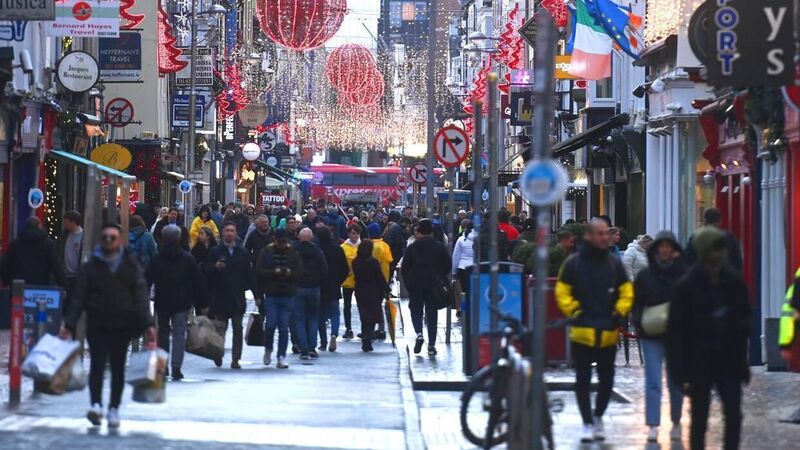Now is the ideal time to make all of Cork city pedestrianised

The works will include the replacement of damaged pedestrian crossings with new granite paving, replacement of damaged street furniture including bollards, bike stands, tree surrounds, signs and poles, raised seating, and the replacement of road surfacing and line markings as required.
The work will continue to mid-August. As traffic and bus routes are diverted off the main street, is this an opportunity to introduce pedestrianisation for all of the centre of Cork city?
This is not as extreme as it seems. Many of the major cities across Europe are ‘streets’ ahead of us in terms of inputting street design that removes the strangle-hold of cars and in-built reliance on fossil fuels.
The ‘One Simple Trick’ is the phrase being used to describe how Paris was able to transform its air quality and thus the quality of life in the city in the run-up to the 2024 Summer Olympics.
What is the trick? Kicking out cars.
Mike Galliardi, of NBC, succinctly summed up the impact of the initiative. “A campaign to make Paris greener by reducing its dependence on cars, has transformed it into a shining example of what many environmental activists, city planners and transit advocates say ought to be the future of cities worldwide.”
Ahead of the upcoming Olympics, the city has succeeded in a major reduction in air pollution. Compared to a decade ago, when Paris Mayor Anne Hidalgo first took office, air pollution in Paris has been sliced by 40%.
This has been achieved by an iron will to improve the accessibility of the city to pedestrians, cyclists and scooter-riders.
These figures show exactly what can be achieved by challenging vested interests with strategic urban planning and transport reforms. And it is not just air quality that has improved. The city has seen an upsurge in the quality of life for its residents - showing that meaningful change can be achieved and is within reach.
By removing cars from the streets, space for active travel and public transport automatically means vastly improved networks and services.
Barcelona is another densely populated city that has embraced the prospect of lowering fossil fuel emissions and tackling air pollution.
As part of the Superilla (Superblocks) project that started in 2013, the city created a cluster of green quieter streets in small neighbourhoods across the city, closed to traffic, where residents can play and socialise.
People reported better rest, more interaction and less noise and air pollution. Now, under an ambitious plan called Eixos Verds (Green Axis), local government plans to extend the project across much of the city.
Having walked through these flower-filled, sun dappled spaces with residents of all ages eating, chatting, playing, shopping, strolling, you wonder why any street was ever designed to be anything less.
A study in Environment International found that the Green Axis Project, if fully implemented, would prevent 14% of self-perceived poor mental health, reduce visits to mental health facilities by 13%, reduce antidepressant use by 13%, and sedative use by 8% each year.
“This study helps illustrate that greening is a relevant strategy to promote health and particularly mental health in urban settings,” co-author Diana Vidal Yánez, from Barcelona University, concluded.
And we badly need to move more. A major new report from the World Health Organisation (WHO) reported recently that nearly a third of all adults are not doing enough physical activity, posing a threat to health across the world.
More than 31% of adults - 1.8 billion people - did not get the recommended amount of physical exercise in 2022, an increase of five percentage points from 2010, according to the study.
“Physical activity is a silent threat to health, contributing significantly to the burden of chronic disease,” said Rudiger Krech, director of the WHO health promotion department.
The WHO recommends all adults spend at least 150 minutes every week doing moderate-intensity physical activity - which can include walking, cycling or even household chores - or at least 75 minutes of vigorous exercise, such as running or competing in sport.
This means the WHO’s goal of reducing physical inactivity by 15% by the end of the decade would continue to go in the opposite direction.
The research showed a gender gap, with over a third of women not reaching the activity threshold compared to 29% of men. Reasons for activity rates declining include: people are walking less, working at computers more and generally spending more leisure time at screens.
The study is billed as the most comprehensive to look at the subject yet, an international team combined the findings from more than 500 studies involving 5.7 million people across 153 countries and territories.
Walking or cycling into the city centre - a 15 or 20 minute journey for many - rather than using the car - would add up to a major chunk of that 150 minutes of a week, even if it is done two or three times a week.
The WHO emphasised that changing individual behaviour is not enough, calling on countries to promote physical activity by boosting community sports as well as walking cycling and public transport. Is the City Council prepared to step up to the challenge?
The long overdue refurbishment of Cork city streets this summer is an ideal opportunity for the City Council to follow the lead of major European cities that have taken the plunge and pedestrianised.
These cities are now enjoying the benefits - cooler green spaces, fewer greenhouse gas emissions and traffic exhaust fumes, more active travel to improves air quality and physical health, and a pleasant place to socialise, shop and meet friends that has unquantifiable benefits to mental health.
If walking or cycling was a pill for physical and mental health, we would all be swallowing it regularly. A refurbished and pedestrianised city centre would make it much easier to swallow.
Dr Catherine Conlon is a public health doctor with the HSE in Cork.







 App?
App?




